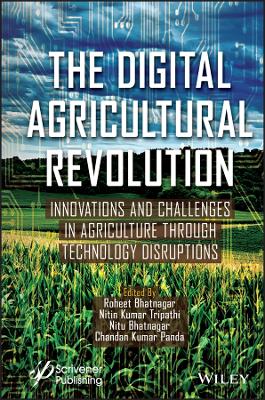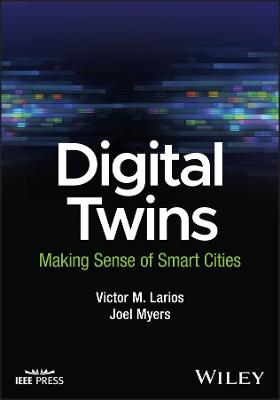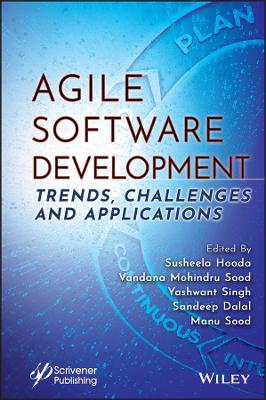Digital Agricultural Revolution
 -15%
portes grátis
-15%
portes grátis
Digital Agricultural Revolution
Innovations and Challenges in Agriculture through Technology Disruptions
Bhatnagar, Nitu; Bhatnagar, Roheet; Panda, Chandan Kumar; Tripathi, Nitin Kumar
John Wiley & Sons Inc
08/2022
496
Dura
Inglês
9781119823339
15 a 20 dias
763
1 Scope and Recent Trends of Artificial Intelligence in Indian Agriculture 1
X. Anitha Mary, Vladimir Popov, Kumudha Raimond, I. Johnson and S. J.Vijay
1.1 Introduction 2
1.2 Different Forms of AI 2
1.3 Different Technologies in AI 3
1.3.1 Machine Learning 4
1.3.1.1 Data Pre-processing 5
1.3.1.2 Feature Extraction 5
1.3.1.3 Working With Data Sets 6
1.3.1.4 Model Development 6
1.3.1.5 Improving the Model With New Data 8
1.3.2 Artificial Neural Network 8
1.3.2.1 ANN in Agriculture 9
1.3.3 Deep Learning for Smart Agriculture 9
1.3.3.1 Data Pre-processing 10
1.3.3.2 Data Augmentation 10
1.3.3.3 Different DL Models 10
1.4 AI With Big Data and Internet of Things 11
1.5 AI in the Lifecycle of the Agricultural Process 12
1.5.1 Improving Crop Sowing and Productivity 12
1.5.2 Soil Health Monitoring 13
1.5.3 Weed and Pest Control 14
1.5.4 Water Management 14
1.5.5 Crop Harvesting 15
1.6 Indian Agriculture and Smart Farming 15
1.6.1 Sensors for Smart Farming 16
1.7 Advantages of Using AI in Agriculture 17
1.8 Role of AI in Indian Agriculture 18
1.9 Case Study in Plant Disease Identification Using AI Technology-Tomato and Potato Crops 19
1.10 Challenges in AI 20
1.11 Conclusion 21
References 21
2 Comparative Evaluation of Neural Networks in Crop Yield Prediction of Paddy and Sugarcane Crop 25
K. Krupavathi, M. Raghu Babu and A. Mani
2.1 Introduction 26
2.2 Introduction to Artificial Neural Networks 27
2.2.1 Overview of Artificial Neural Networks 27
2.2.2 Components of Neural Networks 28
2.2.3 Types and Suitability of Neural Networks 29
2.3 Application of Neural Networks in Agriculture 30
2.3.1 Potential Applications of Neural Networks in Agriculture 30
2.3.2 Significance of Neural Networks in Crop Yield Prediction 32
2.4 Importance of Remote Sensing in Crop Yield Estimation 32
2.5 Derivation of Crop-Sensitive Parameters From Remote Sensing for Paddy and Sugarcane Crops 33
2.5.1 Study Area 33
2.5.2 Materials and Methods 35
2.5.2.1 Data Acquisition and Crop Parameters Retrieval From Remote Sensing Images 35
2.5.3 Results and Conclusions 37
2.6 Neural Network Model Development, Calibration and Validation 40
2.6.1 Materials and Methods 40
2.6.1.1 ANN Model Design 40
2.6.1.2 Model Training 42
2.6.1.3 Model Validation 43
2.6.2 Results and Conclusions 43
2.7 Conclusion 50
References 50
3 Smart Irrigation Systems Using Machine Learning and Control Theory 57
Meric Cetin and Selami Beyhan
3.1 Machine Learning for Irrigation Systems 58
3.2 Control Theory for Irrigation Systems 62
3.2.1 Application Literature 65
3.2.2 An Evaluation of Machine Learning-Based Irrigation Control Applications 72
3.2.3 Remote Control Extensions 72
3.3 Conclusion and Future Directions 75
References 79
4 Enabling Technologies for Future Robotic Agriculture Systems: A Case Study in Indian Scenario 87
X. Anitha Mary, Kannan Mani, Kumudha Raimond, Johnson I. and Dinesh Kumar P.
4.1 Need for Robotics in Agriculture 88
4.2 Different Types of Agricultural Bots 89
4.2.1 Field Robots 89
4.2.2 Drones 90
4.2.3 Livestock Drones 91
4.2.4 Multirobot System 91
4.3 Existing Agricultural Robots 91
4.4 Precision Agriculture and Robotics 93
4.5 Technologies for Smart Farming 94
4.5.1 Concepts of Internet of Things 94
4.5.2 Big Data 94
4.5.3 Cyber Physical System 95
4.5.4 Cloud Computing 95
4.6 Impact of AI and Robotics in Agriculture 95
4.7 Unmanned Aerial Vehicles (UAV) in Agriculture 98
4.8 Agricultural Manipulators 99
4.9 Ethical Impact of Robotics and AI 99
4.10 Scope of Agribots in India 100
4.11 Challenges in the Deployment of Robots 101
4.12 Future Scope of Robotics in Agriculture 102
4.13 Conclusion 103
References 103
5 The Applications of Industry 4.0 (I4.0) Technologies in the Palm Oil Industry in Colombia (Latin America) 109
James Perez-Moron and Ana Susana Cantillo-Orozco
5.1 Introduction 110
5.2 Methodology 113
5.2.1 Sample Selection 113
5.3 Results Analysis 118
5.3.1 Data Visualization 122
5.3.2 Cooccurrence 123
5.3.3 Coauthorship 123
5.3.4 Citation 124
5.3.5 Cocitation 125
5.4 Colombia PO Industry 126
5.5 The PO Industry and the Circular Economy 130
5.6 Conclusion 131
5.7 Further Recommendations for the Colombian PO Industry 132
Acknowledgments 133
References 133
6 Intelligent Multiagent System for Agricultural Management Processes (Case Study: Greenhouse) 143
Djamel Saba, Youcef Sahli and Abdelkader Hadidi
Abbreviations 144
6.1 Introduction 144
6.2 Modern Agricultural Methods 146
6.3 Internet of Things Applications in Smart Agriculture 148
6.4 Artificial Intelligence 149
6.4.1 Overview of AI 149
6.4.2 Branches of DAI 151
6.4.3 The Differences Between MAS and Computing Paradigms 153
6.5 MAS 155
6.5.1 Overview of MAS 155
6.5.2 MAS Simulation 157
6.6 Design and Implementation 159
6.6.1 Conception of the Solution 159
6.6.1.1 The Existing Study 159
6.6.1.2 Agents List 160
6.6.2 Introduction to the System Implementation 161
6.6.2.1 Environment 161
6.6.2.2 Group Communication (Multicast) 162
6.6.2.3 Message Transport 162
6.6.2.4 Data Exchange Format 162
6.6.2.5 Cooperation 163
6.6.2.6 Coordination 164
6.6.2.7 Negotiation 164
6.7 Analysis and Discussion 164
6.8 Conclusion 167
References 168
7 Smart Irrigation System for Smart Agricultural Using IoT: Concepts, Architecture, and Applications 171
Abdelkader Hadidi, Djamel Saba and Youcef Sahli
7.1 Introduction 172
7.2 Irrigation Systems 173
7.2.1 Agricultural Irrigation Techniques 174
7.2.2 Surface Irrigation Systems 174
7.2.3 Sprinkler Irrigation 177
7.2.4 Micro-Irrigation Systems 178
7.2.5 Comparison of Irrigation Methods 178
7.2.6 Efficiency of Irrigation Systems 179
7.3 IoT 180
7.3.1 IoT History 180
7.3.2 IoT Architecture 181
7.3.3 Examples of Uses for the IoT 182
7.3.4 IoT Importance in Different Sectors 183
7.4 IoT Applications in Agriculture 184
7.4.1 Precision Cultivation 184
7.4.2 Agricultural Unmanned Aircraft 184
7.4.3 Livestock Control 185
7.4.4 Smart Greenhouses 185
7.5 IoT and Water Management 185
7.6 Introduction to the Implementation 186
7.7 Analysis and Discussion 192
7.8 Conclusion 193
References 194
8 The Internet of Things (IoT) for Sustainable Agriculture 199
Sadiq, M.S., Singh, I.P., Ahmad, M.M. and Karunakaran, N.
8.1 Introduction 200
8.2 ICT in Agriculture 202
8.3 Internet of Things in Agriculture and Allied Sector 203
8.3.1 Precision Farming 205
8.3.2 Agriculture Drones 208
8.3.3 Livestock Monitoring 209
8.3.4 Smart Greenhouses 210
8.4 Geospatial Technology 211
8.4.1 Remote Sensing 211
8.4.2 Geographic Information System 215
8.4.3 GPS for Agriculture Resources Mapping 217
8.5 Summary and Conclusion 222
References 223
9 Advances in Bionic Approaches for Agriculture and Forestry Development 225
Vipin Parkash, Anuj Chauhan, Akshita Gaur and Nishant Rai
9.1 Introduction 226
9.2 Precision Farming 227
9.2.1 Nanosensors and Its Role in Agriculture 229
9.2.1.1 Nanobiosensor Use for Heavy Metal Detection 230
9.2.1.2 Nanobiosensors Use for Urea Detection 230
9.2.1.3 Nanosensors for Soil Analysis 231
9.2.1.4 Nanosensors for Disease Assessment 231
9.3 Powerful Role of Drones in Agriculture 231
9.3.1 Unmanned Aerial Vehicle Providing Crop Data 232
9.3.2 Using Raw Data to Produce Useful Information 233
9.3.3 Crop Health Surveillance and Monitoring 239
9.4 Nanobionics in Plants 240
9.5 Role of Nanotechnology in Forestry 241
9.5.1 Chemotaxonomy 243
9.5.2 Wood and Paper Processing 244
9.6 Conclusion 246
References 246
10 Simulation of Water Management Processes of Distributed Irrigation Systems 255
Aysulu Aydarova
10.1 Introduction 255
10.2 Modeling of Water Facilities 256
10.3 Processing and Conducting Experiments 264
10.4 Conclusion 266
References 266
11 Conceptual Principles of Reengineering of Agricultural Resources: Open Problems, Challenges and Future Trends 269
Zamlynskyi Viktor, Livinskyi Anatolii, Zamlynska Olha and Minakova Svetlana
11.1 Introduction 270
11.2 Modern Agronomy and Approaches for Environment Sustenance 272
11.2.1 Sustainable Agriculture 273
11.3 International Federation of Organic Agriculture Movements (IFOAM) and Significance 278
11.4 Low Cost versus Sustainable Agricultural Production 280
11.5 Change of Trends in Agriculture 284
References 287
12 Role of Agritech Start-Ups in Supply Chain-An Organizational Approach of Ninjacart 289
D. Rafi and Md. Mubeena
12.1 Introduction 290
12.2 How Does the Chain Work? 291
12.3 Undisrupted Chain of Ninjacart During Pandemic-19 297
12.4 Conclusion 298
References 298
13 Institutional Model of Integrating Agricultural Production Technologies with Accounting and Information Systems 301
Nataliya Kantsedal and Oksana Ponomarenko
13.1 Introduction 302
13.2 Research Methodology 302
13.3 The General Model of a New Informational Paradigm of Agricultural Activities' Organization 303
13.4 The Model of Institutional Interaction of Information Agents in Agricultural Production 305
13.5 Conclusions 308
References 309
14 Relevance of Artificial Intelligence in Wastewater Management 311
Poornima Ramesh, Kathirvel Suganya, T. Uma Maheswari, S. Paul Sebastian and K. Sara Parwin Banu
14.1 Introduction 312
14.2 Digital Technologies and Industrial Sustainability 313
14.3 Artificial Neural Networks and Its Categories 315
14.4 AI in Technical Performance 316
14.5 AI in Economic Performance 322
14.6 AI in Management Performance 323
14.7 AI in Wastewater Reuse 324
14.8 Conclusion 325
References 326
15 Risks of Agrobusiness Digital Transformation 333
Inna Riepina, Anastasiia Koval, Olexandr Starikov and Volodymyr Tokar
15.1 Modern Global Trends in Agriculture 334
15.2 The Global Innovative Differentiation 337
15.3 National Indicative Planning of Innovative Transformations 342
15.4 Key Myths and Risks of Digitalization of Agrobusiness 349
15.5 Examples of Use of Digital Technologies in Agriculture 350
15.6 Imperatives of Transforming the Region into a Cost-Effective Ecosystem of Digital Highly Productive and Risk-Free Agriculture 351
15.7 Conclusion 354
References 356
16 Water Resource Management in Distributed Irrigation Systems 359
Varlamova Lyudmila P., Yakubov ?aqsadhon S. and Elmurodova Barno E.
16.1 Introduction 360
16.2 Types of Mathematical Models for Modeling the Process of Managing Irrigation Channels 360
16.3 Building a River Model 362
16.3.1 Classification of Models by Solution Methods 364
16.3.2 Method of Characteristics 364
16.3.3 Hydrological Analogy Method 365
16.3.4 Analysis of Works on the Formulation of Boundary Value Problems 367
16.4 Spatial Hierarchy of River Terrain 369
16.4.1 Small Drainage Basin Study Scheme 371
16.4.2 Modeling Water Management in Uzbekistan 371
16.4.3 Stages of Developing a Water Resources Management Model 371
16.5 Organizations in the Structure of Water Resources Management 374
16.6 Conclusion 375
References 375
17 Digital Transformation via Blockchain in the Agricultural Commodity Value Chain 379
Necla I. Kuecuekcolak and Ali Sabri Taylan
17.1 Introduction 380
17.2 Precision Agriculture for Food Supply Security 380
17.2.1 Smart Agriculture Business 381
17.2.2 Trading Venues for Contract Farming, Crowdfunding and E-Trades 384
17.3 Blockchain Technology Practices and Literature Reviews on Food Supply Chain 386
17.3.1 Food Supply Chain 388
17.3.2 Smart Contracts 389
17.4 Agricultural Sector Value Chain Digitalization 391
17.4.1 Digital Solution for Contract Farming 391
17.4.2 Commodity Funding 392
17.4.2.1 Smart Contracts 392
17.4.2.2 Crowdfunding Token Trading 393
17.4.3 Digital Transfer System 393
17.5 Conclusion 395
References 395
18 Role of Start-Ups in Altering Agrimarket Channel (Input-Output) 399
D. Rafi and Md. Mubeena
18.1 Introduction 400
18.2 Agriculture Supply Chain Management 400
18.3 How Start-Ups Fill the Concerns and Gaps in Agri Input Supply Chain? 402
18.4 Output Supply Chain 404
18.5 How Start-Ups are Filling the Concerns and Gaps in Agri Output Supply Chain? 407
18.6 Conclusion 408
References 409
19 Development of Blockchain Agriculture Supply Chain Framework Using Social Network Theory: An Empirical Evidence Based on Malaysian Agriculture Firms 411
Muhammad Shabir Shaharudin, Yudi Fernando, Yuvaraj Ganesan and Faizah Shahudin
19.1 Introduction 412
19.2 Literature Review 413
19.2.1 Agriculture Malaysia 413
19.2.2 Agriculture Supply Chain 415
19.2.3 Blockchain Technology 416
19.2.4 Blockchain Agriculture Supply Chain Management 418
19.2.5 Social Network Theory 419
19.2.6 Social Network Analysis 420
19.3 Methodology 421
19.3.1 Blockchain Agriculture Supply Chain Management Framework 421
19.3.2 Research Design 423
19.4 Results and Discussion 424
19.4.1 Demographic Profiles 424
19.4.2 Social Network Analysis Results 424
19.5 Conclusion 440
19.6 Acknowledgment 441
References 441
20 Potential Options and Applications of Machine Learning in Soil Science 447
Anandkumar Naorem, Shiva Kumar Udayana and Somasundaram Jayaraman
20.1 Introduction: A Deep Insight on Machine Learning, Deep Learning and Artificial Intelligence 448
20.2 Application of ML in Soil Science 449
20.3 Classification of ML Techniques 452
20.3.1 Supervised ML 453
20.3.2 Unsupervised ML 453
20.3.3 Reinforcement ML 453
20.4 Artificial Neural Network 454
20.5 Support Vector Machine 455
20.6 Conclusion 457
References 457
Index 461
1 Scope and Recent Trends of Artificial Intelligence in Indian Agriculture 1
X. Anitha Mary, Vladimir Popov, Kumudha Raimond, I. Johnson and S. J.Vijay
1.1 Introduction 2
1.2 Different Forms of AI 2
1.3 Different Technologies in AI 3
1.3.1 Machine Learning 4
1.3.1.1 Data Pre-processing 5
1.3.1.2 Feature Extraction 5
1.3.1.3 Working With Data Sets 6
1.3.1.4 Model Development 6
1.3.1.5 Improving the Model With New Data 8
1.3.2 Artificial Neural Network 8
1.3.2.1 ANN in Agriculture 9
1.3.3 Deep Learning for Smart Agriculture 9
1.3.3.1 Data Pre-processing 10
1.3.3.2 Data Augmentation 10
1.3.3.3 Different DL Models 10
1.4 AI With Big Data and Internet of Things 11
1.5 AI in the Lifecycle of the Agricultural Process 12
1.5.1 Improving Crop Sowing and Productivity 12
1.5.2 Soil Health Monitoring 13
1.5.3 Weed and Pest Control 14
1.5.4 Water Management 14
1.5.5 Crop Harvesting 15
1.6 Indian Agriculture and Smart Farming 15
1.6.1 Sensors for Smart Farming 16
1.7 Advantages of Using AI in Agriculture 17
1.8 Role of AI in Indian Agriculture 18
1.9 Case Study in Plant Disease Identification Using AI Technology-Tomato and Potato Crops 19
1.10 Challenges in AI 20
1.11 Conclusion 21
References 21
2 Comparative Evaluation of Neural Networks in Crop Yield Prediction of Paddy and Sugarcane Crop 25
K. Krupavathi, M. Raghu Babu and A. Mani
2.1 Introduction 26
2.2 Introduction to Artificial Neural Networks 27
2.2.1 Overview of Artificial Neural Networks 27
2.2.2 Components of Neural Networks 28
2.2.3 Types and Suitability of Neural Networks 29
2.3 Application of Neural Networks in Agriculture 30
2.3.1 Potential Applications of Neural Networks in Agriculture 30
2.3.2 Significance of Neural Networks in Crop Yield Prediction 32
2.4 Importance of Remote Sensing in Crop Yield Estimation 32
2.5 Derivation of Crop-Sensitive Parameters From Remote Sensing for Paddy and Sugarcane Crops 33
2.5.1 Study Area 33
2.5.2 Materials and Methods 35
2.5.2.1 Data Acquisition and Crop Parameters Retrieval From Remote Sensing Images 35
2.5.3 Results and Conclusions 37
2.6 Neural Network Model Development, Calibration and Validation 40
2.6.1 Materials and Methods 40
2.6.1.1 ANN Model Design 40
2.6.1.2 Model Training 42
2.6.1.3 Model Validation 43
2.6.2 Results and Conclusions 43
2.7 Conclusion 50
References 50
3 Smart Irrigation Systems Using Machine Learning and Control Theory 57
Meric Cetin and Selami Beyhan
3.1 Machine Learning for Irrigation Systems 58
3.2 Control Theory for Irrigation Systems 62
3.2.1 Application Literature 65
3.2.2 An Evaluation of Machine Learning-Based Irrigation Control Applications 72
3.2.3 Remote Control Extensions 72
3.3 Conclusion and Future Directions 75
References 79
4 Enabling Technologies for Future Robotic Agriculture Systems: A Case Study in Indian Scenario 87
X. Anitha Mary, Kannan Mani, Kumudha Raimond, Johnson I. and Dinesh Kumar P.
4.1 Need for Robotics in Agriculture 88
4.2 Different Types of Agricultural Bots 89
4.2.1 Field Robots 89
4.2.2 Drones 90
4.2.3 Livestock Drones 91
4.2.4 Multirobot System 91
4.3 Existing Agricultural Robots 91
4.4 Precision Agriculture and Robotics 93
4.5 Technologies for Smart Farming 94
4.5.1 Concepts of Internet of Things 94
4.5.2 Big Data 94
4.5.3 Cyber Physical System 95
4.5.4 Cloud Computing 95
4.6 Impact of AI and Robotics in Agriculture 95
4.7 Unmanned Aerial Vehicles (UAV) in Agriculture 98
4.8 Agricultural Manipulators 99
4.9 Ethical Impact of Robotics and AI 99
4.10 Scope of Agribots in India 100
4.11 Challenges in the Deployment of Robots 101
4.12 Future Scope of Robotics in Agriculture 102
4.13 Conclusion 103
References 103
5 The Applications of Industry 4.0 (I4.0) Technologies in the Palm Oil Industry in Colombia (Latin America) 109
James Perez-Moron and Ana Susana Cantillo-Orozco
5.1 Introduction 110
5.2 Methodology 113
5.2.1 Sample Selection 113
5.3 Results Analysis 118
5.3.1 Data Visualization 122
5.3.2 Cooccurrence 123
5.3.3 Coauthorship 123
5.3.4 Citation 124
5.3.5 Cocitation 125
5.4 Colombia PO Industry 126
5.5 The PO Industry and the Circular Economy 130
5.6 Conclusion 131
5.7 Further Recommendations for the Colombian PO Industry 132
Acknowledgments 133
References 133
6 Intelligent Multiagent System for Agricultural Management Processes (Case Study: Greenhouse) 143
Djamel Saba, Youcef Sahli and Abdelkader Hadidi
Abbreviations 144
6.1 Introduction 144
6.2 Modern Agricultural Methods 146
6.3 Internet of Things Applications in Smart Agriculture 148
6.4 Artificial Intelligence 149
6.4.1 Overview of AI 149
6.4.2 Branches of DAI 151
6.4.3 The Differences Between MAS and Computing Paradigms 153
6.5 MAS 155
6.5.1 Overview of MAS 155
6.5.2 MAS Simulation 157
6.6 Design and Implementation 159
6.6.1 Conception of the Solution 159
6.6.1.1 The Existing Study 159
6.6.1.2 Agents List 160
6.6.2 Introduction to the System Implementation 161
6.6.2.1 Environment 161
6.6.2.2 Group Communication (Multicast) 162
6.6.2.3 Message Transport 162
6.6.2.4 Data Exchange Format 162
6.6.2.5 Cooperation 163
6.6.2.6 Coordination 164
6.6.2.7 Negotiation 164
6.7 Analysis and Discussion 164
6.8 Conclusion 167
References 168
7 Smart Irrigation System for Smart Agricultural Using IoT: Concepts, Architecture, and Applications 171
Abdelkader Hadidi, Djamel Saba and Youcef Sahli
7.1 Introduction 172
7.2 Irrigation Systems 173
7.2.1 Agricultural Irrigation Techniques 174
7.2.2 Surface Irrigation Systems 174
7.2.3 Sprinkler Irrigation 177
7.2.4 Micro-Irrigation Systems 178
7.2.5 Comparison of Irrigation Methods 178
7.2.6 Efficiency of Irrigation Systems 179
7.3 IoT 180
7.3.1 IoT History 180
7.3.2 IoT Architecture 181
7.3.3 Examples of Uses for the IoT 182
7.3.4 IoT Importance in Different Sectors 183
7.4 IoT Applications in Agriculture 184
7.4.1 Precision Cultivation 184
7.4.2 Agricultural Unmanned Aircraft 184
7.4.3 Livestock Control 185
7.4.4 Smart Greenhouses 185
7.5 IoT and Water Management 185
7.6 Introduction to the Implementation 186
7.7 Analysis and Discussion 192
7.8 Conclusion 193
References 194
8 The Internet of Things (IoT) for Sustainable Agriculture 199
Sadiq, M.S., Singh, I.P., Ahmad, M.M. and Karunakaran, N.
8.1 Introduction 200
8.2 ICT in Agriculture 202
8.3 Internet of Things in Agriculture and Allied Sector 203
8.3.1 Precision Farming 205
8.3.2 Agriculture Drones 208
8.3.3 Livestock Monitoring 209
8.3.4 Smart Greenhouses 210
8.4 Geospatial Technology 211
8.4.1 Remote Sensing 211
8.4.2 Geographic Information System 215
8.4.3 GPS for Agriculture Resources Mapping 217
8.5 Summary and Conclusion 222
References 223
9 Advances in Bionic Approaches for Agriculture and Forestry Development 225
Vipin Parkash, Anuj Chauhan, Akshita Gaur and Nishant Rai
9.1 Introduction 226
9.2 Precision Farming 227
9.2.1 Nanosensors and Its Role in Agriculture 229
9.2.1.1 Nanobiosensor Use for Heavy Metal Detection 230
9.2.1.2 Nanobiosensors Use for Urea Detection 230
9.2.1.3 Nanosensors for Soil Analysis 231
9.2.1.4 Nanosensors for Disease Assessment 231
9.3 Powerful Role of Drones in Agriculture 231
9.3.1 Unmanned Aerial Vehicle Providing Crop Data 232
9.3.2 Using Raw Data to Produce Useful Information 233
9.3.3 Crop Health Surveillance and Monitoring 239
9.4 Nanobionics in Plants 240
9.5 Role of Nanotechnology in Forestry 241
9.5.1 Chemotaxonomy 243
9.5.2 Wood and Paper Processing 244
9.6 Conclusion 246
References 246
10 Simulation of Water Management Processes of Distributed Irrigation Systems 255
Aysulu Aydarova
10.1 Introduction 255
10.2 Modeling of Water Facilities 256
10.3 Processing and Conducting Experiments 264
10.4 Conclusion 266
References 266
11 Conceptual Principles of Reengineering of Agricultural Resources: Open Problems, Challenges and Future Trends 269
Zamlynskyi Viktor, Livinskyi Anatolii, Zamlynska Olha and Minakova Svetlana
11.1 Introduction 270
11.2 Modern Agronomy and Approaches for Environment Sustenance 272
11.2.1 Sustainable Agriculture 273
11.3 International Federation of Organic Agriculture Movements (IFOAM) and Significance 278
11.4 Low Cost versus Sustainable Agricultural Production 280
11.5 Change of Trends in Agriculture 284
References 287
12 Role of Agritech Start-Ups in Supply Chain-An Organizational Approach of Ninjacart 289
D. Rafi and Md. Mubeena
12.1 Introduction 290
12.2 How Does the Chain Work? 291
12.3 Undisrupted Chain of Ninjacart During Pandemic-19 297
12.4 Conclusion 298
References 298
13 Institutional Model of Integrating Agricultural Production Technologies with Accounting and Information Systems 301
Nataliya Kantsedal and Oksana Ponomarenko
13.1 Introduction 302
13.2 Research Methodology 302
13.3 The General Model of a New Informational Paradigm of Agricultural Activities' Organization 303
13.4 The Model of Institutional Interaction of Information Agents in Agricultural Production 305
13.5 Conclusions 308
References 309
14 Relevance of Artificial Intelligence in Wastewater Management 311
Poornima Ramesh, Kathirvel Suganya, T. Uma Maheswari, S. Paul Sebastian and K. Sara Parwin Banu
14.1 Introduction 312
14.2 Digital Technologies and Industrial Sustainability 313
14.3 Artificial Neural Networks and Its Categories 315
14.4 AI in Technical Performance 316
14.5 AI in Economic Performance 322
14.6 AI in Management Performance 323
14.7 AI in Wastewater Reuse 324
14.8 Conclusion 325
References 326
15 Risks of Agrobusiness Digital Transformation 333
Inna Riepina, Anastasiia Koval, Olexandr Starikov and Volodymyr Tokar
15.1 Modern Global Trends in Agriculture 334
15.2 The Global Innovative Differentiation 337
15.3 National Indicative Planning of Innovative Transformations 342
15.4 Key Myths and Risks of Digitalization of Agrobusiness 349
15.5 Examples of Use of Digital Technologies in Agriculture 350
15.6 Imperatives of Transforming the Region into a Cost-Effective Ecosystem of Digital Highly Productive and Risk-Free Agriculture 351
15.7 Conclusion 354
References 356
16 Water Resource Management in Distributed Irrigation Systems 359
Varlamova Lyudmila P., Yakubov ?aqsadhon S. and Elmurodova Barno E.
16.1 Introduction 360
16.2 Types of Mathematical Models for Modeling the Process of Managing Irrigation Channels 360
16.3 Building a River Model 362
16.3.1 Classification of Models by Solution Methods 364
16.3.2 Method of Characteristics 364
16.3.3 Hydrological Analogy Method 365
16.3.4 Analysis of Works on the Formulation of Boundary Value Problems 367
16.4 Spatial Hierarchy of River Terrain 369
16.4.1 Small Drainage Basin Study Scheme 371
16.4.2 Modeling Water Management in Uzbekistan 371
16.4.3 Stages of Developing a Water Resources Management Model 371
16.5 Organizations in the Structure of Water Resources Management 374
16.6 Conclusion 375
References 375
17 Digital Transformation via Blockchain in the Agricultural Commodity Value Chain 379
Necla I. Kuecuekcolak and Ali Sabri Taylan
17.1 Introduction 380
17.2 Precision Agriculture for Food Supply Security 380
17.2.1 Smart Agriculture Business 381
17.2.2 Trading Venues for Contract Farming, Crowdfunding and E-Trades 384
17.3 Blockchain Technology Practices and Literature Reviews on Food Supply Chain 386
17.3.1 Food Supply Chain 388
17.3.2 Smart Contracts 389
17.4 Agricultural Sector Value Chain Digitalization 391
17.4.1 Digital Solution for Contract Farming 391
17.4.2 Commodity Funding 392
17.4.2.1 Smart Contracts 392
17.4.2.2 Crowdfunding Token Trading 393
17.4.3 Digital Transfer System 393
17.5 Conclusion 395
References 395
18 Role of Start-Ups in Altering Agrimarket Channel (Input-Output) 399
D. Rafi and Md. Mubeena
18.1 Introduction 400
18.2 Agriculture Supply Chain Management 400
18.3 How Start-Ups Fill the Concerns and Gaps in Agri Input Supply Chain? 402
18.4 Output Supply Chain 404
18.5 How Start-Ups are Filling the Concerns and Gaps in Agri Output Supply Chain? 407
18.6 Conclusion 408
References 409
19 Development of Blockchain Agriculture Supply Chain Framework Using Social Network Theory: An Empirical Evidence Based on Malaysian Agriculture Firms 411
Muhammad Shabir Shaharudin, Yudi Fernando, Yuvaraj Ganesan and Faizah Shahudin
19.1 Introduction 412
19.2 Literature Review 413
19.2.1 Agriculture Malaysia 413
19.2.2 Agriculture Supply Chain 415
19.2.3 Blockchain Technology 416
19.2.4 Blockchain Agriculture Supply Chain Management 418
19.2.5 Social Network Theory 419
19.2.6 Social Network Analysis 420
19.3 Methodology 421
19.3.1 Blockchain Agriculture Supply Chain Management Framework 421
19.3.2 Research Design 423
19.4 Results and Discussion 424
19.4.1 Demographic Profiles 424
19.4.2 Social Network Analysis Results 424
19.5 Conclusion 440
19.6 Acknowledgment 441
References 441
20 Potential Options and Applications of Machine Learning in Soil Science 447
Anandkumar Naorem, Shiva Kumar Udayana and Somasundaram Jayaraman
20.1 Introduction: A Deep Insight on Machine Learning, Deep Learning and Artificial Intelligence 448
20.2 Application of ML in Soil Science 449
20.3 Classification of ML Techniques 452
20.3.1 Supervised ML 453
20.3.2 Unsupervised ML 453
20.3.3 Reinforcement ML 453
20.4 Artificial Neural Network 454
20.5 Support Vector Machine 455
20.6 Conclusion 457
References 457
Index 461







